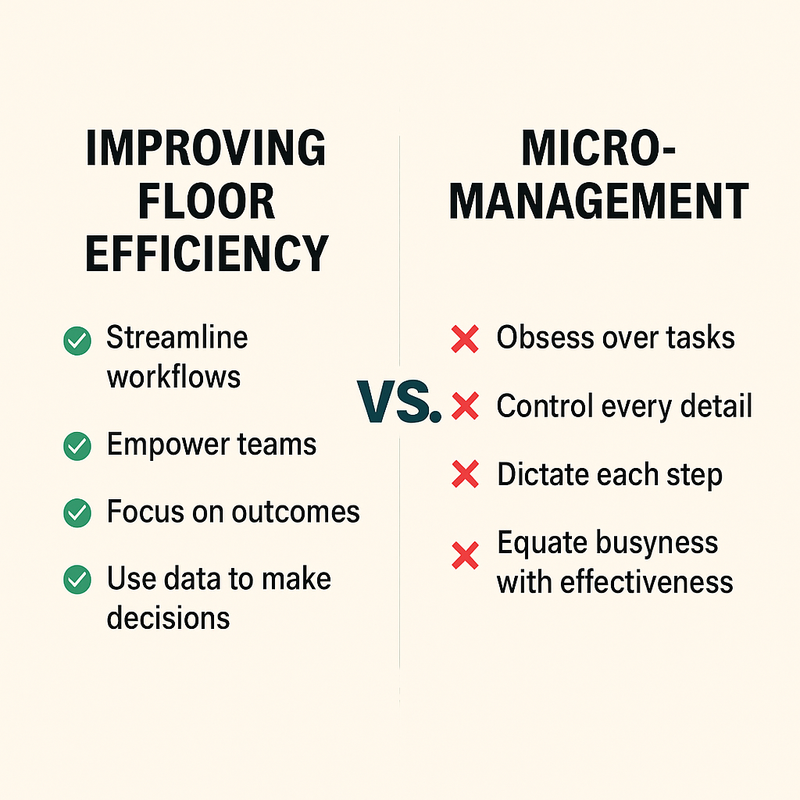In the world of project management and operations, there's a razor-thin line between driving performance and driving your team insane.
I've walked that line.
And I’ve seen too many managers cross it—usually with the best intentions, but ending in disastrous outcomes.
So let’s cut through the fluff and talk brass tacks about two often misunderstood (and misused) terms:
Improving Floor Efficiency vs. Micromanagement
Let’s get one thing straight:
Improving efficiency is a strategy. Micromanagement is a control issue.
This is about optimizing systems, not suffocating people. It means:
· - Streamlining workflows
· - Reducing process redundancies
· - Enhancing communication pipelines
· - Empowering teams with the right tools
· - Creating measurable KPIs aligned with business goals
· - Building autonomy and accountability into team culture
Bottom line: You’re setting your team up to win—without hovering over every mouse click.
Micromanagement is leadership insecurity dressed up as “being hands-on.” You know it’s happening when:
· - You're obsessed with how every single task is done
· - You double-check work that’s already been quality-checked
· - You reassign tasks “because you can do it faster”
· - Your team is afraid to experiment, fail, or speak up
· - You equate busyness with effectiveness
Let’s be real: Micromanagement kills trust. It kills morale. It kills innovation.
Micromanagement often masquerades as “high standards.” But here’s the truth:
It’s usually a symptom of:
· - A lack of trust
· - A lack of clarity
· - Broken leadership systems
From what I’ve seen:
- A new manager doesn’t trust their team yet
- A senior leader is afraid to lose control
- An org culture is obsessed with “perfect delivery” instead of sustainable processes
And yeah—I get it. Deadlines are tight. Clients are demanding. The stakes are high.
But micromanagement is a quick fix with long-term damage.
When you improve efficiency, you don’t create chaos—you create freedom. Here’s how:
Don’t rely on tribal knowledge or Slack threads. Create SOPs, documented flows, and automation tools.
Clarity reduces decision fatigue and increases speed.
Define outcomes, not methods. Let your team use their expertise.
People rise to responsibility when given autonomy.
Missing targets? Ask why using metrics—not emotions.
Is the process broken? Are there bottlenecks? Are we measuring the right KPIs?
A manager who mentors their team scales capacity. A micromanager just multiplies stress.
Invest in skill-building. Lead with context, not control.
Continuous improvement isn’t about louder instructions—it’s about smarter systems.
Weekly retros, process audits, and team huddles help you course-correct faster.
· - Am I solving problems at the system level—or just reacting to task-level noise?
· - Does my team feel empowered to own their work—or are they waiting for my green light?
· - When I walk the floor—am I adding value or just pressure?
Here’s the brutal truth I’ve learned after years in the trenches:
The most efficient floors aren’t managed tighter. They’re managed smarter.
The goal of a great leader isn’t to control every task.
It’s to build an environment where people perform at their best without being watched like hawks.
Don’t mistake movement for progress.
Don’t confuse control with leadership.
If you want real efficiency, start letting go of micromanagement—and start building systems, trust, and autonomy into your operations.
That’s how you build teams that don’t just deliver—they thrive.



 Dojo Suggestion
Dojo Suggestion


